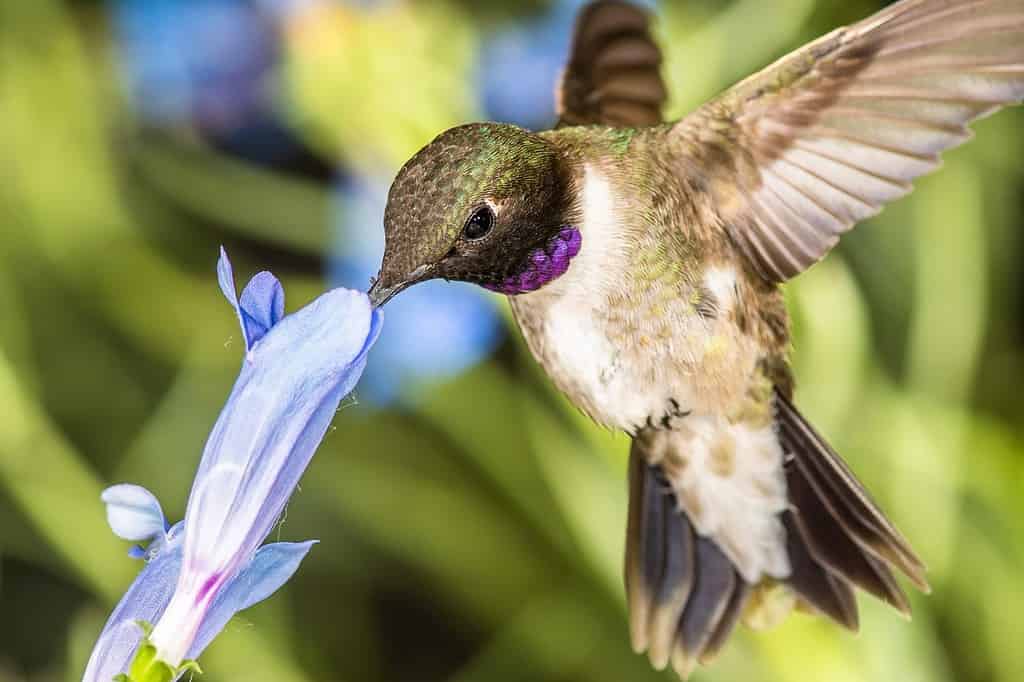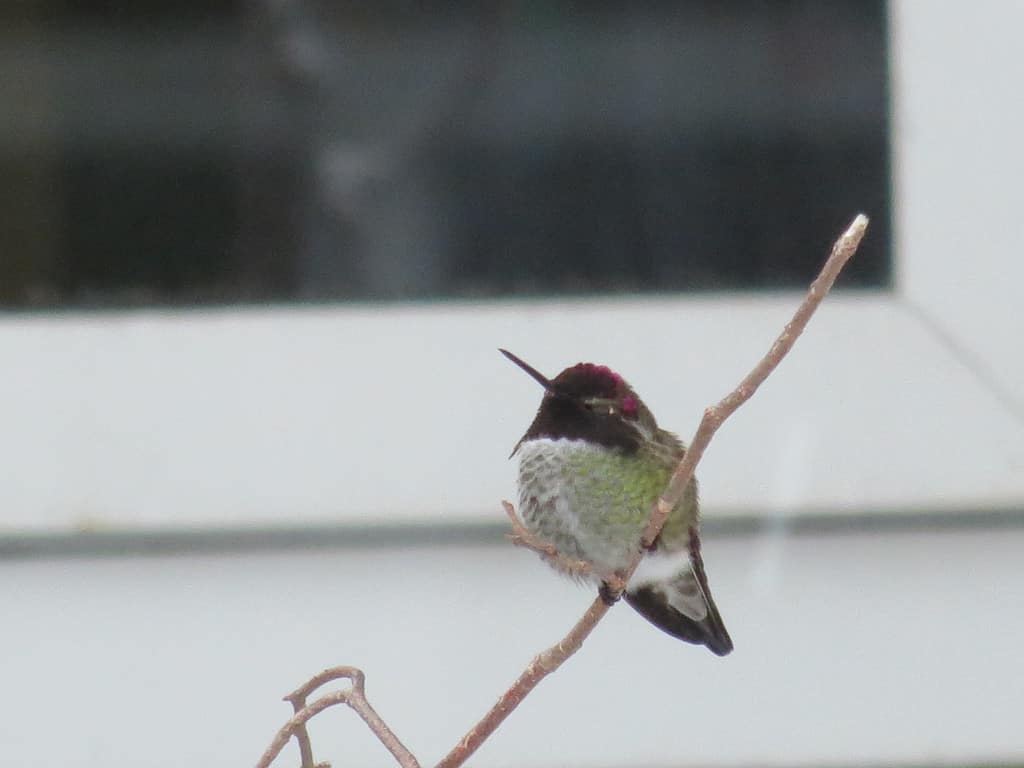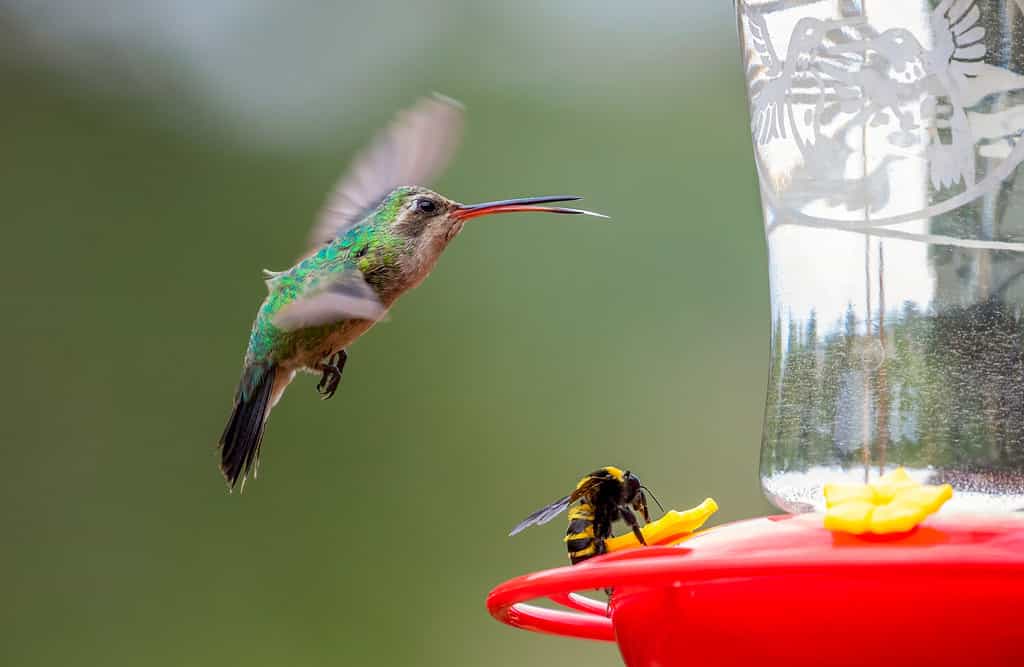Some of you might be familiar with the rule of three. Typically, humans can go three minutes without oxygen, three days without water, and three weeks without food. While some animals can go weeks or months without food, others have to eat every few hours. Let’s find out how long hummingbirds can go without food and answer other common questions about their health and metabolism.
Hummingbirds: A Brief Overview

The average lifespan of a hummingbird is somewhere between three and five years.
©rck_953/Shutterstock.com
There are roughly 360 species of hummingbirds currently recognized. One of the key features of these animals is their specialized flight. Compared to other birds, hummingbirds can fly forward, backward, and upside down. In addition, they have such control over their flight that they can even remain hovering in the same spot. These animals get their name from the humming noise that their wings make while beating so rapidly. High metabolism, vibrant feathers, and an elongated, thin beak are also key characteristics.
Hummingbirds use their tongues to extract nectar from plants. However, instead of slurping it up like some people might be picturing, their tongue is forked off into two segments which they use to lap up fluid. According to Project Beak, “The part of their tongue that is not forked has two grooves in it that look like two tiny troughs stuck together. When a hummingbird sticks its tongue into a flower, the nectar is drawn up into the two “troughs.” There is no suction going on. Instead, these grooves are drawing the nectar to them in much the same way a paper towel draws up water. This process is called capillary action.”
How Long Can Hummingbirds Go Without Food?

Most hummingbirds weigh about as much as a nickel.
©Wang LiQiang/Shutterstock.com
Although many animals can withstand at least a few hours without food, hummingbirds are not so fortunate. Hummingbirds must eat at least once every five hours at minimum in order to survive. For some hummingbirds, this time is as little as three hours. According to the Adirondack Council, “They consume about half their body weight in bugs and nectar, feeding every 10-15 minutes and visiting 1,000-2,000 flowers throughout the day. In addition to nectar from flowers and feeders, these birds eat small insects, beetles, ants, aphids, gnats, mosquitoes, and wasps.”
How Do Hummingbirds Sleep?

Hummingbirds have the ability to beat their wings between 60 and 80 times per second.
©Storm / CC BY-SA 2.0 – License
Although these tiny creatures are able to extract most of the nutrients from the food they eat, they must eat continuously to maintain their body weight. Due to the hummingbird’s incredibly high metabolism, they must eat almost constantly. This means that their life is mostly spent eating or looking for food. With such high intake needs, you might think that finding time to rest would be challenging. However, these clever creatures have worked a way around this. While hummingbirds sleep at night, they enter a state of hibernation. They slow their heart rate and drop their body temperature in order to reserve resources. Although this tactic is effective, most hummingbirds lose weight while sleeping regardless. Once they wake up for the day, they must set out and start looking for food all over again.
Why Do Hummingbirds Have Such High Intake Needs?

Hummingbirds are capable of eating 12 times their body weight per day.
©K A STUDIO/Shutterstock.com
As we stated earlier, hummingbirds have an incredibly high metabolism, which is a main contributing factor to their high caloric needs. They expend an incredible amount of energy throughout their day, and their heart can beat as many as 1,200 times per minute. Hummingbirds burn off the energy provided to them through food at a much quicker rate and need to be in near-constant consumption to maintain their body weight. If humans had the same needs as hummingbirds, we would need to eat roughly three hundred hamburgers per day. Most of our time would be spent finding hamburgers or eating them, and our social lives would be completely altered.
How Can We Help Hummingbirds?

Hummingbirds belong to the family Trochilidae.
©Danita Delimont/Shutterstock.com
Because hummingbirds have such high intake needs, humans can set up hummingbird feeders in order to help them along the way. Although flower nectar and insects are dietary staples, a hummingbird would be just as happy to see a feeder in a time of need. In addition, gardeners can plant flowers that attract hummingbirds, such as bee balm, geranium, and morning glories are some of the most effective. These flowers will likely also attract insects suitable for hummingbirds to eat, so keeping a diverse and healthy garden has many benefits for these birds.
Final Thoughts
Although we may not think about hummingbirds often, these tiny creatures are some of the most impressive and unique birds out there. Their relentless effort to search for food is quite inspiring, if not a little concerning for us humans. Despite this, hummingbirds are accustomed to this life, and they are perfectly capable of getting their needs met. Even though they are tiny, they sure are mighty!
The photo featured at the top of this post is © Jiri Hrebicek/Shutterstock.com
Thank you for reading! Have some feedback for us? Contact the AZ Animals editorial team.






